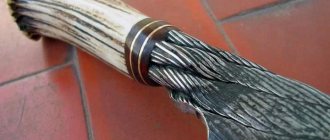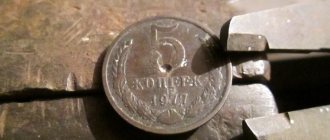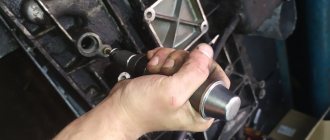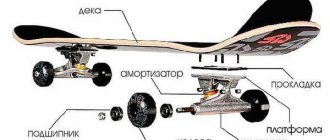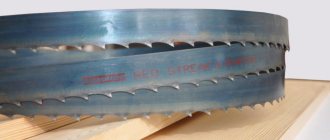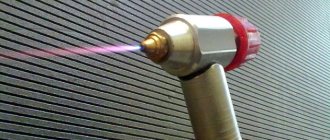When tightening nuts and bolts (especially during the repair of suspension joints, intake manifold and other vehicle components), it is necessary to strictly observe the specified tightening torque. Detailed information about acceptable values can be easily found on the Internet.
By maintaining the exact tightening torque of nuts and bolts, the mating surfaces fit together more tightly and evenly. It is for tightening with a certain force that a torque wrench is used, which can be mechanical or semi-automatic.
Such a tool is not cheap, so it doesn’t make sense to buy it just to use it a couple of times. Of course, if you have extra money, you can buy a torque wrench. However, if your main goal is to save money and make do with improvised means, then in this case it makes more sense to make an almost torque wrench with your own hands.
What is a torque wrench used for?
A certain tightening torque on the mating parts is necessary for uniform contact of the planes. In addition, if a gasket is installed along the contour, the uneven force of the bolted connections can destroy it.
A torque wrench allows you to tighten bolts with an accuracy of hundredths of a millimeter. In addition, it is often necessary to perform torque tightening of the bearing seat with high precision.
The manufacturer calculates torque values based on the type of material and design features of the unit. When building a car at a factory, all fasteners are tightened according to specifications: as a rule, this work is performed by assembly robots.
And when servicing, repairing, replacing parts, the required force is provided by a hand tool: a torque wrench.
Its main advantage is the ability to work in a wide range of settings. You simply set the operating limit with your own hands, or visually control the dynamometer needle.
That is, a universal torque wrench does not allow you to equally accurately tighten the nuts with a force of 2 N.m. and 100 N.m.
Tool manufacturers produce torque wrenches in several ranges:
- the most popular “size”: 40 – 210 N.m. It allows you to perform most repair work on the vehicle chassis;
- A precise torque wrench (from 2 N.m. to 50 N.m.) is intended for engine repair and maintenance. Setting up the carburetor, tightening the spark plugs, assembling the crankshaft and connecting rods. Work on replacing the intake or exhaust systems is also carried out with a small range torque wrench;
- tightening limit from 200 N.m. and higher is intended for power elements of powerful structures. In relation to cars - perhaps only wheel nuts.
Electronic DMK
Calibration involves checking the readings of the instrument, adjusting it and reconfiguring it if necessary. And the same verification is called verification. That is, you need to periodically check whether the torque set on the key actually corresponds to the tightening torque. If the scale says 100, then it should tighten with a torque of 100 Nm. Over time and with frequent use, the setting gets lost.
The choice depends on how much error is allowed during the tightening process. If a part needs to be tightened as accurately as possible, a pointer DMK is capable of tightening, for example.
As for the manufacturer itself, you should look for a key from the range of the following brands:
The advantage of such DMKs is the possibility of maximum precise tuning.
The instruments in question come in different types by design, however, the principle of their operation is the same. To understand the peculiarities of the functioning of torque wrenches, you should know their structure. The tools consist of the following components:
The main role in the tool under consideration is played by the spring, due to which the corresponding amount of pressing force is set. This spring is highly accurate and reliable. To control the amount of force set, the instruments have scales with divisions. Using this scale you can check the tightening force of all bolted connections.
So does a car owner need a torque wrench?
Some car owners and even some auto mechanics argue that a torque wrench, in general, for the average car enthusiast, is a useless and unnecessary thing. The wheels, they say, can be tightened without much precision, but everything else is the job of a specialist.
Meanwhile, these craftsmen themselves do not deny that they carry out repairs and replacements of many components on their cars themselves. Another thing is that over time, experience appears and a fairly accurate feeling of the sufficiency of the effort being applied, especially when it is a familiar and thoroughly familiar car. What should those who do not have such experience do? Broken bolts, broken studs, broken nuts or heads can all be the result of not having a torque wrench. Especially today, when foreign-made cars actively use various alloys and non-ferrous metals.
In addition, a torque wrench allows you to achieve such an important thing as uniform tightening of all bolts or nuts, which even on a wheel will not be at all superfluous, but there are situations where this is a prerequisite.
How does a torque wrench work and where is it used?
Recently, adapters called dynamometers have gained popularity among car enthusiasts. This is an electronic product; it is connected to the ratchet through its own mechanical drive. The kit includes an adapter for attachments and heads. Power is supplied from internal batteries. The device is universal and easy to use.
The answer to the question “how to choose the right wrench?” in the case of ratchet wrenches sounds simple - use the operating instructions and specifications, then wait for the characteristic sound while working. In the case of arrow keys, you just need to follow the arrow on the scale and stop tightening this connection in time when the required force is reached.
Torque wrenches are used where the calculated force of a threaded connection is required - in metalworking, construction, and automobile repair.
Required Tools and Process
In order to do it correctly, you will need:
- set of socket heads;
- extension;
- ratchet/wrench;
- torque wrench.
The replacement process itself should be performed according to the following scheme:
- Disconnect the wires leading to the emergency oil level and coolant temperature sensors.
- Drain the coolant.
- Remove the thermostat.
- Remove the air filter housing.
- Disconnect the exhaust pipe inlet from the manifold.
- Remove the casing, as well as the camshaft belt itself.
- Disconnect the drive rods of both dampers from the carburetor.
- Disconnect the wires going to the cylinder head.
- Disconnect the hoses suitable for the cylinder head by loosening their clamps.
- Remove the cylinder head.
- Remove the worn gasket.
- Clean the contact surface of the cylinder head from any remaining gasket material.
Installing the gasket and mounting the cylinder head in place is carried out in exactly the same sequence, but in reverse order. At the same time, it is worth paying close attention to such a factor as the tightening torque of the cylinder head of the VAZ 2114 8 valves - we will talk about it below.
Tips from professionals when making a key
The tool may not work the first time, and the measurement will be incorrect. However, any experienced master can give several detailed tips, following which every beginner will achieve the desired result.
If you do not have a lever or materials for it, you can use a regular wrench with an open-end grip on one side and a box grip on the opposite side. However, the ratio of length and torque should be calculated more carefully here, since the size of the arm will most likely be a fractional number.
For better fixation of the steelyard to the lever, you should be especially careful about the place where it is installed. The best option is a carefully drilled through hole, exactly at the point where the load is applied, and the device will never slip off the handle.
Working with a homemade torque wrench
Depending on the required tension, the master may have several steelyards with different weighing limits, each of which must have its own table depending on the load on the arm and torque.
Since all efforts when determining the degree of tightening are applied only to the scales, it is necessary to ensure a comfortable grip on the handle, since 20-30 kg with a poor grip will not allow you to comfortably work with the device.
General rules for using the tool
The tool itself is a rod with a handle at one end and an indicator mechanism at the other. At the working end of the handle, a socket head or a connecting socket for a horn attachment (wrench or union attachment) is installed.
The keys are equipped with indicator and adjustment mechanisms, both with and without overtightening protection.
Next, we will consider the types of torque wrenches that are most often used in work.
Click type
Often motorists purchase just such a key because of the high measurement accuracy, durability and the presence of a convenient scale with adjustment. It is impossible to tighten the thread with such a wrench, since a fuse is provided.
The main thing is to know how to properly work with a product of this type. The bottom line is that it is necessary to set the required value of the maximum force (tightening torque) in advance.
Next, the connection (bolt or nut) is tightened as usual until a clearly audible click appears. This sound signals that the required parameter has been reached. It is noteworthy that the device will then go into the “slip” mode and it will not be possible to tighten the connection.
Click type
It's no secret that all bolted connections must be tightened to a certain torque. In the literature it is often referred to as newton times a meter. N*m. For example, 10 N*m means that the bolt or nut is tightened with a torque of 10 newtons applied to a 1 meter long arm.
I don’t want to seem boastful, but the results are already there and I think they’re good for a start. Sorry for this slight digression from the topic. Today we’ll talk about the topic of torque wrench. What is it and what is it eaten with.
Which torque wrench to choose from these three types. Based on my operating experience, I will say that the best option for a garage mechanic is a click torque wrench. I will try to clearly justify this choice.
More homemade products: How to stick protective glass on a smartphone correctly - steps with photos
The following types of torque wrenches are distinguished according to the indication method:
The torque wrench consists of the following elements:
How does a torque wrench work for a car?
There are two design solutions: torque limitation and visual process control. Let's look at each of them in detail.
Popular: Why are old batteries being bought up all over the country?
The so-called ratchet
Externally, it is not much different from a conventional lever with a ratchet for socket heads. Actually, this is what she is. A simple ratcheting mechanism with adjustable operating force turns an ordinary handle into a torque wrench. The secret is in the design of the ratchet. It allows the gear to rotate in any direction.
In the return direction, when you retract the handle for the next rotation of the head, the force is minimal. But in the working direction, where force is applied, the ratchet tooth jumps off the gear when the specified value is reached.
In the handle of the shank there is a rotating nozzle. It adjusts the tension of the ratchet spring.
How does the system work?
When the set torque value is reached, the ratchet gear begins to slip. The handle turns with a characteristic sound, but the nut does not tighten.
The ratcheting torque wrench is semi-automatic. It makes it possible to tighten the nuts without fear of overtightening them.
Measuring scale
The torque wrench does not have a torque limiting mechanism, but a dial or digital dynamometer is connected to the rotary mechanism. When force is applied to the handle, the needle deflects and the value of the applied force can be recorded.
The principle of operation is quite simple: the arrow maintains a constant position relative to the head of the key, and the handle bends like a spring torsion bar. As a result, the scale shifts relative to the tip of the arrow in proportion to the applied force.
The disadvantage of this model is that there is no automatic limiter. You simply control the force applied to the handle. This allows for a more accurate measurement (unlike a ratchet, which operates discretely), but there is a possibility of mechanical error when dosing force.
It is difficult to make a homemade torque wrench based on a ratchet; the technology requires metal-working machines and precision calibration. But a tool with a dynamometer is quite within the capabilities of a home craftsman.
Torque wrenches, their design and components
That is why such mechanisms indicate the maximum or recommended tightening force. These data are indicated directly in the passport data of the mechanisms or components. The parts should be tightened to the appropriate amount to ensure a reliable and effective connection.
More homemade products: How to make copper sulfate at home - photos with steps
The reliability of mechanisms depends not only on the quality of the materials used, but also on the correct assembly of the components. In most cases, the use of specialized tools is required to ensure the reliability of threaded connections. These tools include a torque wrench, the purpose, types and selection of which should be familiarized with before you buy it.
Based on the display of relevant readings, the types of devices under consideration are divided into types. It is necessary to know what types of torque wrenches there are in order to choose the appropriate option for performing the corresponding manipulations. It should be noted that the instruments in question are quite expensive, so if it is necessary to use a device, its selection must be approached accordingly.
The dimensions of the key and fasteners must strictly correspond
Correctly, the torque of the connections should be indicated in the technical document
Judging by user reviews, there is no consensus on the quality and properties of the tool. This situation is understandable, since the level of qualifications and the specifics of the work performed can be very different, and therefore points of view differ significantly from each other.
Replacing the oil pressure sensor
To install a new sensor, you will need the following tools and consumables: two wrenches for “21”, an open-end wrench for “22” with an adapter, a rubber protective cap, an O-ring and block (usually included in the kit), a wire terminal for the sensor contact. Before replacement, you must remove the negative terminal from the battery. Operating procedure:
Remove the rubber protective cap from the top of the sensor and disconnect the wiring terminals. Unscrew the sensor from the fitting using a “21” wrench, carefully holding the tip of the fitting with a key of the same size. Remove the sensor. An O-ring and a metal washer are installed at the connection between the sensor and the fitting, which must be replaced if they are worn. The new sensor is installed in the reverse order.
Varieties
Tighten the nuts; is a torque wrench necessary?
Before choosing torque wrenches for cars, you should study the available product options. This will help you get to know the devices better, and roughly understand what you need and what characteristics or capabilities you should count on when purchasing it.
It is customary to distinguish 3 types of torque wrenches. But you can add one more device to this list, which is an adapter key.
- Switches. When it comes to which torque wrench you should choose for repairing your own car in a garage, many are inclined to the simplest and most affordable option in the form of a pointer device. This key has a simple design and low cost. But the low price hides the corresponding quality. In terms of accuracy, they are much inferior to competitors, having an error of up to 10%. In this case, you should not count on a maximum tightening torque of more than 280 Nm. This key is not in demand among professional auto mechanics. But if you are doing work in the garage, and the procedure itself does not require increased accuracy, a pointer tool should be sufficient.
- Clicky. They are the ultimate. When choosing a torque wrench for car maintenance, motorists often lean towards click tools. Structurally, it includes a clutch with a given torque, which begins to operate when the specified tightening parameters are exceeded. For such tools, the torque range can vary from 40 to 360 Nm, which already significantly exceeds the capabilities of a standard pointer device. This range greatly simplifies the selection of a specific tool with the required characteristics. Click devices can be divided into household and professional ones. For the former, the error indicators do not exceed 5%, while for the latter it is even at a level of up to 3%. But in cost they are superior to switch analogues.
- Electronic. If there are increased demands on the car, it will be much more correct to choose an electronic torque wrench. This is the best tool for car maintenance, although it is rarely found in the garages of ordinary motorists. This is a professional-level device with the highest technical characteristics. The tightening scale here is electronic, and when the desired value is reached, a sound signal is heard, often supplemented by LED indicators. The range starts at 20 Nm. But the most significant feature of such a key is considered to be an error that does not go beyond 1%. The only, but significant reason to refuse to purchase an electronic device is the price. It is really high, which is why such devices are used mainly in car repair shops and service stations.
- Adapter keys. This is a special electronic device that can hardly be considered a type of electronic torque wrench. The device is equipped with a mechanical drive, to which you can connect a ratchet, and install heads and other attachments on the adapter. Dynamometer adapters are equipped with various components. There are sets of several adapters that differ in range. The device has a digital display and additional buttons for settings. The operating principle is similar to electronic keys. There is a battery inside the box. At the same time, the price is significantly lower than that of electronic torque wrenches.
Arrow torque wrench
The driver himself must decide which torque wrench he should choose for further maintenance of his own passenger car.
If you literally carry out some work on the machine several times a year, when you need 1-2 uses of such a key, there is definitely no need to spend a lot of money on buying an electronic device. It’s much easier and cheaper to go to a car service center. But for such periodic work, click devices are perfect. They are much better than pointers, have a good percentage of error, and at the same time cost adequate money.
How to use a torque wrench
It should be taken into account that even key samples of the same type may have their own requirements and operating features, so you cannot use the tool without studying the technical description or instructions. The calibration interval must also be maintained to ensure accurate torque indication.
The maximum force is adjusted by combining the data on the scale of the handle and the key lever. The main scale provides coarse adjustment in steps of 5 Nm, and the additional scale provides fine adjustment within 5 Nm to obtain the exact required value.
Let's look at the features of using different types of keys:
I took MASTAK 012–40210C. The quality is not very good, I took it only because it covers the required range of forces. I recommend taking a closer look at normal brands - KING TONY, Jonnesway, Force. Blinov Artyom https://krasnodar.vseinstrumenti.ru/ruchnoy-instrument/klyuchi/dinamometricheskie/mastak/012–40210c/?respcount=1#tab-Responses
As I wrote above, I decided to use regular batteries; replacing them once every year or two is not difficult)
More homemade products: How to make a parking lot for a car in the country - photos and tips
Convert to Newton*meters: 4.98*0.21*10=10.45 Nm. I took the distance of 0.21 meters as the average between 0.2 and 0.22
To reduce the price tag you must use coupon MD4850
How to measure tightness
To correctly measure the tightening using a homemade device, you need to follow a few simple rules:
- Assemble the device and bring it into working condition - attach the steelyard to the handle, set it to zero, if possible, set the weighing limit with an alarm, and at the end - put the necessary attachment on the working part of the device or initially select an open-end wrench of a suitable size.
- Place the wrench on the nut or bolt. The device will show an accurate value only if the connection with the fastener occurs directly through the lever, and with the participation of one or more adapters and extensions, an error of up to 5-8% is possible when giving the result.
- Carefully pull the steelyard so that its position is strictly perpendicular to the axis of the lever, and the load indicator is not distorted, decomposed into vectors.
- If a normal force has been achieved, the device will confirm this with the measurement result, and the nut will not budge. If the tightening was not sufficient, the fastener will rotate around its axis until the required torque is achieved.
Important!
To prevent the bolt connection from breaking, you should not put an excessive load on the homemade dynamometer, and tighten only at the nominal values prescribed in the technical manual for servicing a particular part in the car. Otherwise, there is a risk of deformation of factory products.
Retightening a bolt on a car wheel
Tightening with hand scales
Alternatively, as a replacement for a factory or homemade torque wrench in the form of a ratchet, you can use a regular wrench or socket wrench. We attach to it a manual scale of the “canter” or “steelyard” type (or you can, for example, take one with a digital display), and tighten the bolt or nut. This is also quite a workable option at home if you don’t have anything at hand.
To tighten nuts or bolts with a certain force using hand scales, most often a steelyard of 20-30 kg and a piece of steel pipe 50 cm long (but possible less) with a suitable internal diameter of at least 25-30 mm will be enough to could be put on the key. In the event that large torques are required, you need to select the appropriate scales.
What you will need for work:
- a wrench (open-end or socket) onto which a piece of steel pipe about 40–50 cm long is placed;
- spring canter (hand scales) with a “limit” of approximately 20–30 kg. You can also use electronic scales to make a torque measuring device.
Tightening process
First, you need to install a spanner or open-end wrench on a bolt or nut, and attach the hook of a hand scale to the other end. Having calculated the required force in advance, we pull the scale ring, while maintaining 90 degrees, until the required value is reached.
Thus, even without having a torque wrench on hand in the garage or workshop, you can tighten the nut and bolt connection with the necessary force and precise torque.
Source
Maximum torque for bolt tightening
The car does not recognize the chip key
In order to properly tighten car bolts and nuts without damaging them, the technician must be aware of the maximum forces depending on the length, diameters of the elements, and the quality of the steel from which they are made. These data on the maximum torque are shown in the table.
| Thread/pitch, mm | Strength class 4.6 | Strength class 5.8 | Strength class 8.8 | Strength class 10.9 | Strength class 12.9 |
| 5/0,8 | 2,1 | 3,5 | 5,5 | 7,8 | 9,3 |
| 6/1,0 | 3,6 | 5,9 | 9,4 | 13,4 | 16,3 |
| 8/1,25 | 8,5 | 14,4 | 23,0 | 31,7 | 38,4 |
| 10/1,5 | 16,3 | 27,8 | 45,1 | 62,4 | 75,8 |
| 12/1,75 | 28,8 | 49,0 | 77,8 | 109,4 | 130,6 |
| 14/2,0 | 46,1 | 76,8 | 122,9 | 173,8 | 208,3 |
| 16/2,0 | 71,0 | 118,1 | 189,1 | 265,9 | 319,7 |
| 18/2,5 | 98,9 | 165,1 | 264,0 | 370,6 | 444,5 |
| 20/2,5 | 138,2 | 230,4 | 369,6 | 519,4 | 623,0 |
| 22/2,5 | 186,2 | 311,0 | 497,3 | 698,9 | 839,0 |
| 24/3,0 | 239,0 | 399,4 | 638,4 | 897,6 | 1075,2 |
| 27/3,0 | 345,6 | 576,0 | 922,6 | 1296,0 | 1555,2 |
| 30/3,5 | 472,3 | 786,2 | 1257,6 | 1766,4 | 2121,6 |
| 33/3,5 | 636,5 | 1056,0 | 1699,2 | 2380,8 | 2860,8 |
| 36/4,0 | 820,8 | 1363,2 | 2188,8 | 3081,6 | 3696,0 |
| 39/4,0 | 1056,0 | 1756,8 | … | 3955,2 | 4742,4 |
As a rule, the instrument scale is graduated in Nm, but sometimes you can see force indicators in kilograms on it.
Torque wrench included with sockets
Main mistakes when making a key
Any high-precision tool cannot be manufactured completely without errors, since the master has neither accurate designs nor drawings at hand, and all this can lead to incorrect measurements and subsequent breakdown of car parts. However, many professionals have answers on this matter, offering car enthusiasts a number of recommendations in order to minimize errors and inaccuracies, in particular:
- You should not use soft metal as a lever, which can easily bend when pressed, because the force applied to the steelyard, without maintaining orthogonality, will not give the desired result, and the purpose of the device will be completely lost.
- You should not choose a cheap steelyard, because the accuracy of its measurements is very questionable, and the spring quickly stretches and fails. So, as of December 2022, the cost of scales should be in the region of 400-500.0 rubles. This is not much compared to the price of the torque wrench itself - about 3-4 thousand rubles, and it is better to change the low-quality component immediately.
- When attaching the nozzle to the nut, you need to take into account that it must be perpendicular to the axis of operation of the lever, otherwise the measurement will not work.
- Most steelyards have only an informational function and do not in any way limit the actions of the master, who can easily get distracted and tighten the bolt without paying attention to the scale reading.
You might be interested in this About High Jack jacks: features of the rack and pinion mechanism, selection criteria
Thus, when using a homemade product, the master bears much more responsibility, because the device cannot have the same automatic force reduction functions as a purchased analogue.
Service station
A homemade device is best used to control bolt tension if in doubt. If it is necessary to control the tightening on any complex component part, the car owner should still contact a service station for diagnostics and repairs, and should not replace important components in his garage, because unauthorized intervention can cost much more than the money saved on the key.
Torque Wrench Selection
The goals you pursue form the basis of the requirements for such tools. The financial aspect is also important. The most expensive will be a key with electronic filling, but if your goal is not to achieve high accuracy, then you can take a closer look at click or torsion models. Don't forget to make sure how it fits in your hand. Comfort of use is very important, because it is necessary not only to keep the instrument intact, but also to avoid damaging its parts and to fit the fingers perfectly. The surface must be selected from non-slip materials so that the hand does not jump off the key at the most inopportune moment. Also, you should not feel any strain on your wrist with prolonged use. And now when all the details are taken into account, you can start purchasing.
Snap torque wrench
The modern design of such keys is designed to achieve the greatest efficiency of use. When the required parameter value is reached, a sound signal is emitted. This signal is different from the clicking sound that is heard when force is applied. The snap-on wrench minimizes confusion when working. Click-type wrenches have fewer moving components, which increases tool reliability and reduces wear. Snap-on keys retain calibration much longer than switch-type keys.
Classification by indication method
The operation of torque wrenches must be carried out taking into account the following features:
A torque wrench is a tool with a built-in torque gauge. It is used to measure the tightening torque of threaded connections. Such a tool is in great demand when carrying out construction work, car repairs, and equipment assembly. It may vary in design features, operating range, additional functions, etc. You can buy a torque wrench in our online store “ShopTool” at reasonable prices.
Among all the attachments, the ratchet attachment is the most effective, significantly increasing the efficiency of the tool. It is possible to use multipliers, with which you can increase the tightening force.
Before tightening the nuts with click-type limit wrenches, you need to set the required torque by rotating the movable drum around the rod with engraved values. On a fixed scale, the values are an order of magnitude higher than the markings of a precise moving scale.
Unfortunately, the “better to over-tighten than under-tighten” method is still in use among motorists. “Curled heads,” bolts, spark plugs, and other “troubles” pulled out along with the threads result in additional labor-intensive work to eliminate them. All you had to do was use a torque wrench for the car.
How the tool works
Semi-automatic torque wrenches resemble in shape and design a regular ratchet wrench, which is used for socket heads. The only significant difference from its “brothers” is the presence of a special ratcheting mechanism, which allows the built-in gear to rotate in two directions.
For example, to return the handle of a tool back after a full rotation, you need to apply relatively little force. But to tighten the nut you need to apply a little more force.
When the required value is reached, the ratchet gear simply begins to slip (a characteristic sound is heard), as a result of which the nut or bolt is no longer tightened. This eliminates the possibility that the thread will break.
Torque wrenches with a force measurement scale by default do not have the ability to limit torque when a specified value is reached. In this case, this moment must be controlled independently using a mechanical or electronic digital measuring scale.
A homemade almost torque wrench, depending on the design, can work according to the example of the first and second options described above.
We recommend: How to make a milling table from an angle grinder
Why do we count Newtons and meters?
Before you start making a simple homemade torque wrench for tightening bolts and nuts, you will need to do some calculations. For example, to achieve a tightening torque of 10 N*m, you need to apply a force equal to one kilogram of force to a lever or arm 1 meter long.
But in a home workshop or garage, a meter lever is not the most practical and convenient option. Ideally, it is better to use a lever within 20–50 cm. And in order to correctly calculate how much force needs to be applied to the lever to achieve the required tightening torque, you need to count Newtons and meters.
However, it is not at all necessary to go into the jungle of mathematical equations. The required values can be easily calculated in proportion. That is, if we take as a basis that to obtain a torque of 10 N*m, you need to apply a force of 1 kg on a meter-long lever, then it is similarly easy to calculate how much force will need to be applied to a lever of shorter length.
The shorter the lever used, the greater the force required to tighten the bolt or nut - this is, so to speak, an axiom. For example, if instead of a meter lever you use a lever 50 cm long, then to obtain a torque of 10 N*m you need to apply a force equal to 2 kg.
If you use a lever with a length of, for example, 22 cm, then the force will be already 4.5 kg. In other words, you need to divide the torque (10 N*m) by the length of the lever (in this case - 0.22 m) and multiply by 0.1. Using this simple formula, you can easily calculate how much specific force is required to tighten the nut.
Buy or make?
In the process of performing auto repair work, almost every vehicle owner is faced with the fact that it is necessary to tighten a bolt or nut by applying a certain force, but there is no torque wrench at hand. Don’t run to the store to buy an expensive instrument, use it for 20–30 minutes and forget it for a year.
We recommend: Universal taganok made of steel pipe and hammer
Therefore, the best option is to make a homemade torque wrench for tightening nuts and bolts. Moreover, you can make a tool like a ratchet with a ratchet mechanism, as well as one made by analogy with a simpler design - using ordinary hand scales.
Torque Control Tools
The main tool for controlling tightening torque is a torque wrench. This is the name of a wrench that has a dynamometer (a device for measuring torque) built into it. The following types of devices exist:
- Indicator - when tightening, displays the applied force digitally or using an arrow. The error is 6–8%.
The indicator torque wrench is inexpensive, but has the largest error - Digital is a subtype of indicator, but uses an LCD display to display the moment. Supports sound notification capabilities, uploading data to a computer, etc. The error is up to 1%.
Digital torque wrench - the most accurate - Limit - when the specified torque is reached, it stops tightening using a click mechanism. The error is up to 4%.
The limit (snap) torque wrench is easy to use
For non-professional use or a small car service, an indicator or limit key is suitable as the most affordable ones. Digital will be in demand in large car service centers.
How to choose the force to tighten the connection correctly
When working with a limit type key, in order to achieve the required torque, you should:
- Before starting tightening, select the required tightening force, for example, 50 Nm. The force is set on the main scale of the device, but not 50, but 48 Nm.
- On the auxiliary scale the force is set to 2 Nm, which in total will give us the required 50 Nm.
- Using a socket of the required size, tighten the nut. When the force reaches 50 Nm, a click will be heard and tightening will stop.
Control of force when working with an indicator type key is carried out visually.
In addition to the torque wrench, you can find torque screwdrivers and screwdrivers on sale; they work on the same principle. When choosing a torque wrench, remember that the tightening torque you need should be 25% less than the maximum allowable for the wrench. Using the key “to the limit”, you will quickly disable it. And also be sure to read the instructions for its use.
Well, you can check the correct tightening of the connection with a protractor.
How to use a homemade torque wrench
Typically, a torque wrench is a fairly expensive tool. Its purchase is unlikely to be justified for private use. However, the simplest device is easy to make yourself. For this you will need:
- ordinary spring scales with a hook and a round scale, allowing you to weigh up to 20 kg (the so-called steelyard);
- a piece of rather thick pipe (2.5 cm) about half a meter long.
Having secured the hook of the scales to the end of the pipe, insert a wrench into the other end and pull the scales, tightening the nut. In this case, to create a torque of 10 Nm, a force of 2 kg will be required. Using this diagram, you can calculate in advance how much force in kilograms you will need to apply to tighten it.
How to make a torque wrench with your own hands so that it is convenient to use?
A meter key handle is not the most practical option. Let's use the rule for calculating force depending on the length of the lever. There is no point in studying formulas; quantities are calculated in proportions.
The shorter the lever, the more force must be applied (while maintaining the amount of torque):
- lever 1 m, torque 10 N.m., force 1 kg;
- lever 0.5 m, torque 10 N.m., force 2 kg;
- lever 33 cm (already convenient to work), torque 10 N.m., force 3 kg.
For production you will need:
- handle for working with square socket heads (for greater versatility - with an extension).
- clamp for fixing the force measurement point.
- measuring device: you can use ordinary scales such as a steelyard or a cantor. The optimal measurement range is from 100 grams to 50 kg.
Having measured the required length from the center of rotation, we fix the clamp on the lever.
The device is ready in 15 minutes. You can mark several points for installing the clamp, depending on the moment being measured.
Important! When tightening the fasteners, you need to pull the scales (dynamometer). We do not apply any force to the handle. A right angle is maintained between the lever and the direction of force (along the cantor spring).
It will be useful to have a ready-made table for calculating torque, depending on the steelyard readings.
If you don’t want to make a separate tool with your own hands, use a standard set of wrenches (open-end on one side, socket on the other). The principle of operation is exactly the same.
For each key (since they are of different lengths), we compile a calculation table in advance. You can use a ready-made smartphone application:
We enter the received data (lever length, cantor readings), and we see the finished result in newtons per meter.
Tighten the bolt with a homemade torque wrench - video
Conclusion: Having a steelyard worth 300 - 500 rubles. (it is found in almost every home), you can save on buying a factory torque wrench: the price is about 2000 - 3000 rubles.
About sports
View all posts by sposport
Torque wrench at home (garage)
| heretic |
Registered:
13 Feb 2011, 01:40
Messages:
1162
From:
Stolniy grad Kiev
Moto:
Honda Transalp 400
Age:
26
Name:
Anton
Rating:
82 [ ? ]
The other day there was a need for a torque wrench. (If anyone doesn’t know, it is needed to tighten the nuts with the required force so that there are no under-tightening or overtightening and, as a result, broken threads or loose/leaky connections). I was puzzled by the issue of purchasing it. I walked around the market and looked at the prices. I was a little disappointed with the paucity of choice and reasonable prices. It turns out that an ordinary car enthusiast needs to pay several hundred hryvnia to tighten a few nuts at the right moment. As an option, you can, of course, contact a service station. But I am always of the opinion that no one can do better if you can do it yourself. The prices for the keys were different: For a torque wrench with an arrow of unknown manufacture with a tightening torque of 0-25 Nm, they asked for 50 hryvnia. A key with a more advanced mechanism that does not allow overtightening, it clicks and turns when the required tightening torque is reached, cost from 150 hryvnia, too of unknown production and it is unclear how long it will last and how accurate it is; besides, the torque range was from 30 or more (up to 100, it seems). The one that was in the range of 0-25 Nm was more expensive. Then I searched online stores and also didn’t find anything available. I found all sorts of branded and electronic keys with and without arrows, the price of which is measured in hundreds of bucks. At the same time, almost none of the other types have a wide range for measuring tightening torque. As a rule, to have a range of, for example, 0-100 Nm, you need to buy as many as 2 keys or pay a lot of bucks for one mega key. In general, the toad crushed me. Therefore, I decided to approach this issue from a slightly different angle.
Theoretically, 1 N•m is the moment of force that a force of 1 N produces on a lever 1 m long. In simple terms, a force of 1 N is approximately the force that creates 0.1 kg applied perpendicular to the end of a meter-long lever.
Naturally, a force of 10 N*m will be equivalent to a force of 1 Kg*M
It turns out that to tighten the nut, for example, by 10 Nm, you need to take a lever 1 M long and apply a force of 1 Kg to it.
The theory is clear, you need a lever and a dynamometer.
Lever arm. Pulling the 1 M lever to tighten a nut in a car is not always and not entirely convenient. You need a shorter lever, so you have to apply a little more force. How many times shorter is the lever, and how much more force must be applied to the lever?
Dynamometer. Conventional household scales of the “canter” type are used to weigh vegetables, fruits, fish, etc. at home. On one side they have a ring, then a spring with a scale in kilograms, then a hook from which to hang the load to be weighed. A canter with a round pointer dial is preferable, because there is greater accuracy.
In total, a real solution to the problem in everyday conditions, if you need to tighten something with the right torque: 1. Lever - any tube 50 cm long (half a meter) if the space where the part is located allows. Or 33 cm (a third of a meter) if it’s not very convenient to get to the long part. We select the diameter of the tube so that it fits on the key (you can even have a slightly larger diameter with a margin, the main thing is that you can turn the key with it like a lever). Or if you use a pipe wrench, make sure that the tube-lever fits onto the wrench’s knob and also so that you can then turn the lever without slipping.
2. Dynamometer - a household cant. Usually they are 10 kg or 20 kg, the smaller the maximum number of kg on the scale, the theoretically more accurate the measurement will be, but it depends on what maximum torque you need to tighten with. For the average user, an ordinary 10 kg cant with a lever of half a meter will make it possible to tighten the nuts with a torque from 0 to 50 Nm ((50 Nm / 10) * 2 = 10 kg). The same 10 Kg weight with a lever of a third of a meter (33 cm) will make it possible to tighten the nuts with a torque from 0 to 33 Nm ((33 Nm/10) * 3 = 10 Kg)
Read also: Device for soldering plastic
For super-advanced users, a 20 kg cantrel with an arrow and a round dial is suitable. With a lever length of half a meter, it will allow you to tighten the nuts up to 100! Nm (100 Nm / 10 * 2 = 20 Kg). If there is little strength in the hands and you need a maximum torque of 100 Nm and one hand cannot squeeze 20 kg, then you can lengthen the lever to 1 m, the force will increase proportionally.
With a lever length of 33 cm (a third of a meter) and a torque of 20 kg, the most optimal option is obtained; it allows you to tighten the nuts from 0 to 66 Nm, which is quite suitable for most tasks.
For myself, I chose a 20 kg household kantyr with an arrow (it cost 30 hryvnia at the market) and a pipe lever 50 cm long and 2.5 cm in diameter (it fits on most keys and with this diameter you can also put it on a knob, for example, a pipe wrench). This combination gives a force reserve of 0..100 Nm. How many kilograms need to be pressed to obtain the required torque for this particular 50 cm lever is calculated simply: 10 Nm = 2 Kg 20 Nm = 4 Kg 30 Nm = 6 Kg 40 Nm = 8 Kg 50 Nm = 10 Kg, etc.
Also, just in case, I prepared a more compact tube with a length of 33 cm. A more optimal option in my opinion. The following rules apply for it: 10 Nm = 3 Kg 20 Nm = 6 Kg 30 Nm = 9 Kg 40 Nm = 12 Kg 50 Nm = 15 Kg, etc.
For example, spark plugs are tightened to a torque of 30 Nm, here a torque wrench can help not to strip the threads. Although this issue can be solved without a dynamometer in a primitive way - by turning it to the desired angle (as old spark plugs advise by 15 degrees, new ones by 90 degrees). Although some “servicemen” tighten the spark plugs so that you can’t unscrew them later, or unscrew them with part of the thread on the spark plug or they don’t tighten them at all, which is also not good. But in other areas of the engine/body it is sometimes impossible to do without a dynamometer.
It works like this. One end of the tube-lever is put on the key, the other end of the tube is attached to the kantyr (you can drill a hole in the tube for easy fastening or screw on which eyelet, in general, whatever happens) and then with one hand we hold the key with the tube on, with the other hand we pull the kantyr perpendicular to the tube ( or in other words, tangentially to the circle along which the key moves along with the tube); We look at the arrow, as soon as the desired moment in kilograms is reached, we stop.
Advantages of the lever-tube over other designs (one of the reasons why I didn’t buy a primitive pointer torque wrench with a square wrench): the tube fits on anything, be it a regular wrench, an adjustable wrench, a hex wrench, a pipe wrench handle, the side of a screwdriver with a t- shaped handle, etc. The same cannot be said about ordinary torque wrenches, which require adapters; you can’t just put them on your tool in everyday conditions.
Perhaps the method described above will be useful to someone else. In any case, for myself, I seem to have solved this problem with torque wrenches and tightening torques. For minor repairs I think this is enough. For major repairs that require a lot of experience and a large amount of work, there is a service station and there’s no getting around it. At least now it’s no longer so scary to unscrew the nuts, which will then need to be screwed in with the required force of X Nm according to the instructions.
| Member of the GEON club |
| Return to top |
| Kamioy |
Registered:
Jul 24, 2011, 11:02 pm
Messages:
1062
From:
Kiev
Age:
43
Name:
Evgeniy
Rating:
78 [ ? ]
1. Stay away from experienced bolt spinners. Especially when it comes to engine assembly.
2. What is stated in the quote looks more like “Advice from a home handyman” from the popular science magazine “Sciences and Life”, published in the 70s and 80s. Of course, if you get the hang of it, you’ll use pliers to tighten the nuts, but it’s still better to have a real Dino wrench. Alternatively, one per crowd.
| Banned |
| Return to top |
| Clin |
Registered:
30 Nov 2011, 11:09
Messages:
593
From:
Kiev
Motorcycle:
Geon County;
Geon Blackster Age:
47
Name:
Anton
Rating:
33 [ ? ]
| GEON clubman |
| Return to top |
| Petrovich |
Registered:
07 Jul 2011, 02:47
Messages:
1562
From:
Kiev
Moto:
XL650V
Age:
46
Tel.:
0508285067
Name:
Oleg
Rating:
137 [ ? ]
| GEON clubman |
| Return to top |
| Page 1 of 1 | [Messages: 4] |
Time zone: UTC + 2 hours [Summer Time]



